2009 HYUNDAI TUCSON ECO mode
[x] Cancel search: ECO modePage 14 of 273
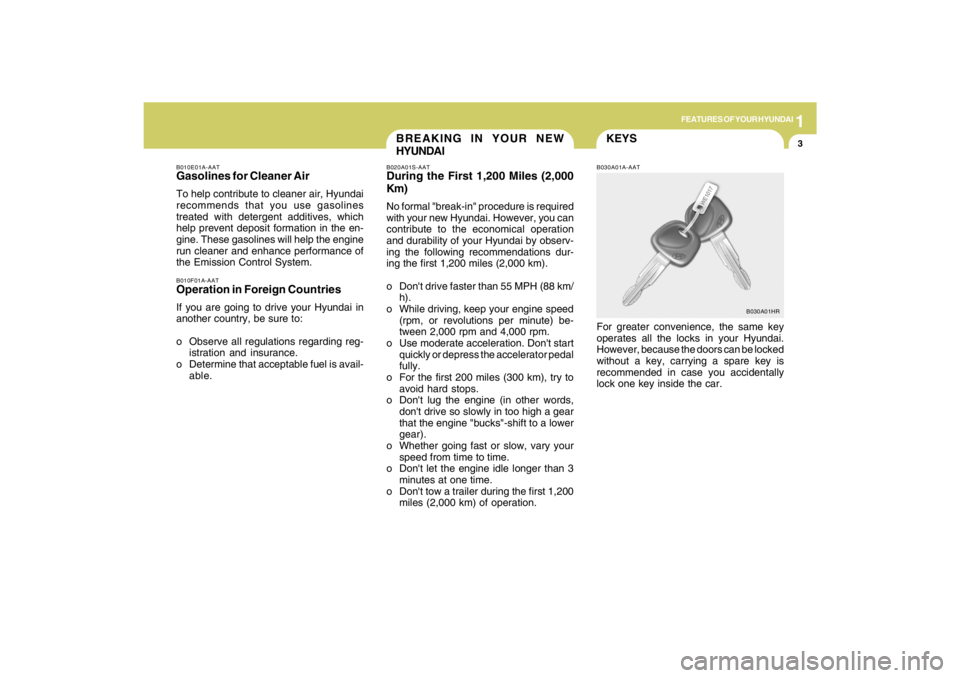
1
FEATURES OF YOUR HYUNDAI
3
KEYS
BREAKING IN YOUR NEW
HYUNDAI
B010F01A-AATOperation in Foreign CountriesIf you are going to drive your Hyundai in
another country, be sure to:
o Observe all regulations regarding reg-
istration and insurance.
o Determine that acceptable fuel is avail-
able.B010E01A-AATGasolines for Cleaner AirTo help contribute to cleaner air, Hyundai
recommends that you use gasolines
treated with detergent additives, which
help prevent deposit formation in the en-
gine. These gasolines will help the engine
run cleaner and enhance performance of
the Emission Control System.
B020A01S-AATDuring the First 1,200 Miles (2,000
Km)No formal "break-in" procedure is required
with your new Hyundai. However, you can
contribute to the economical operation
and durability of your Hyundai by observ-
ing the following recommendations dur-
ing the first 1,200 miles (2,000 km).
o Don't drive faster than 55 MPH (88 km/
h).
o While driving, keep your engine speed
(rpm, or revolutions per minute) be-
tween 2,000 rpm and 4,000 rpm.
o Use moderate acceleration. Don't start
quickly or depress the accelerator pedal
fully.
o For the first 200 miles (300 km), try to
avoid hard stops.
o Don't lug the engine (in other words,
don't drive so slowly in too high a gear
that the engine "bucks"-shift to a lower
gear).
o Whether going fast or slow, vary your
speed from time to time.
o Don't let the engine idle longer than 3
minutes at one time.
o Don't tow a trailer during the first 1,200
miles (2,000 km) of operation.
B030A01A-AATFor greater convenience, the same key
operates all the locks in your Hyundai.
However, because the doors can be locked
without a key, carrying a spare key is
recommended in case you accidentally
lock one key inside the car.
B030A01HR
Page 34 of 273
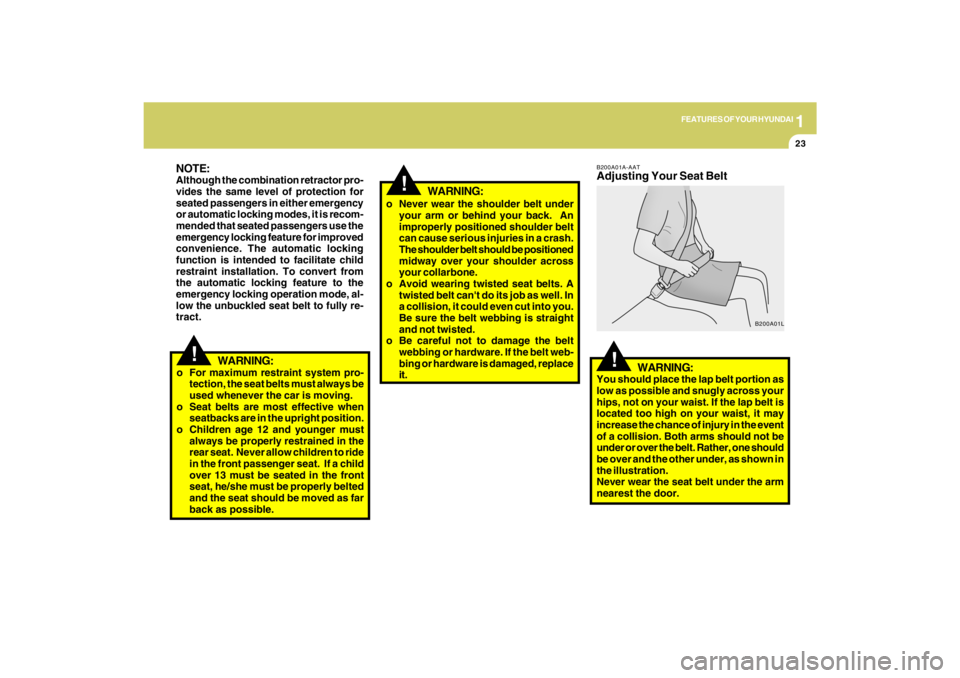
1
FEATURES OF YOUR HYUNDAI
23
!
NOTE:Although the combination retractor pro-
vides the same level of protection for
seated passengers in either emergency
or automatic locking modes, it is recom-
mended that seated passengers use the
emergency locking feature for improved
convenience. The automatic locking
function is intended to facilitate child
restraint installation. To convert from
the automatic locking feature to the
emergency locking operation mode, al-
low the unbuckled seat belt to fully re-
tract.
WARNING:
o For maximum restraint system pro-
tection, the seat belts must always be
used whenever the car is moving.
o Seat belts are most effective when
seatbacks are in the upright position.
o Children age 12 and younger must
always be properly restrained in the
rear seat. Never allow children to ride
in the front passenger seat. If a child
over 13 must be seated in the front
seat, he/she must be properly belted
and the seat should be moved as far
back as possible.
o Never wear the shoulder belt under
your arm or behind your back. An
improperly positioned shoulder belt
can cause serious injuries in a crash.
The shoulder belt should be positioned
midway over your shoulder across
your collarbone.
o Avoid wearing twisted seat belts. A
twisted belt can't do its job as well. In
a collision, it could even cut into you.
Be sure the belt webbing is straight
and not twisted.
o Be careful not to damage the belt
webbing or hardware. If the belt web-
bing or hardware is damaged, replace
it.
!
WARNING:
You should place the lap belt portion as
low as possible and snugly across your
hips, not on your waist. If the lap belt is
located too high on your waist, it may
increase the chance of injury in the event
of a collision. Both arms should not be
under or over the belt. Rather, one should
be over and the other under, as shown in
the illustration.
Never wear the seat belt under the arm
nearest the door.
!
B200A01A-AATAdjusting Your Seat Belt
B200A01L
WARNING:
Page 45 of 273
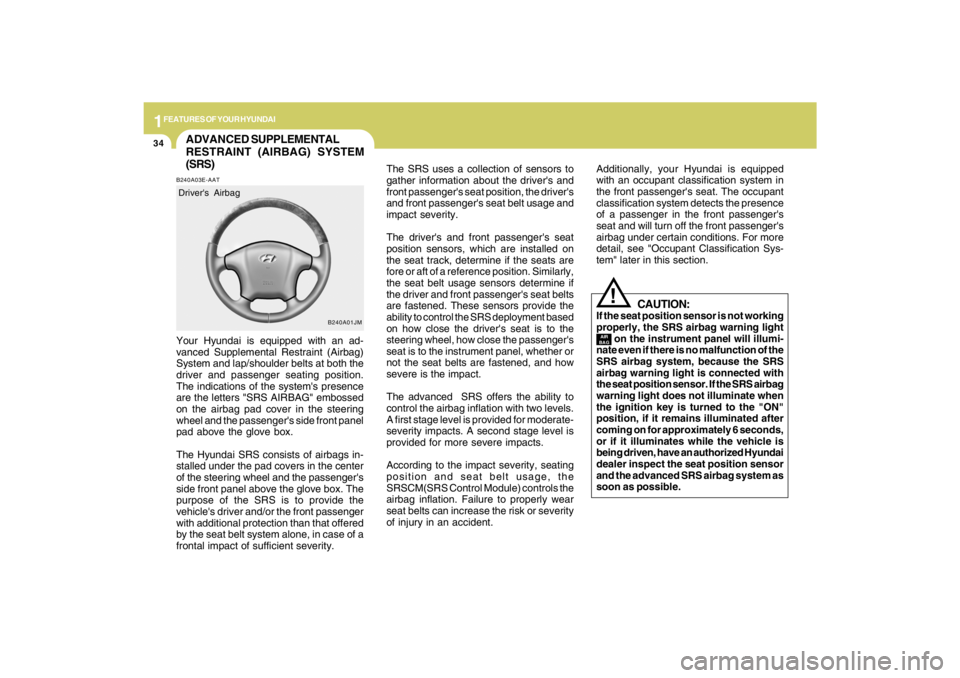
1FEATURES OF YOUR HYUNDAI34
ADVANCED SUPPLEMENTAL
RESTRAINT (AIRBAG) SYSTEM
(SRS)B240A03E-AATYour Hyundai is equipped with an ad-
vanced Supplemental Restraint (Airbag)
System and lap/shoulder belts at both the
driver and passenger seating position.
The indications of the system's presence
are the letters "SRS AIRBAG" embossed
on the airbag pad cover in the steering
wheel and the passenger's side front panel
pad above the glove box.
The Hyundai SRS consists of airbags in-
stalled under the pad covers in the center
of the steering wheel and the passenger's
side front panel above the glove box. The
purpose of the SRS is to provide the
vehicle's driver and/or the front passenger
with additional protection than that offered
by the seat belt system alone, in case of a
frontal impact of sufficient severity.
B240A01JM
Driver's Airbag
The SRS uses a collection of sensors to
gather information about the driver's and
front passenger's seat position, the driver's
and front passenger's seat belt usage and
impact severity.
The driver's and front passenger's seat
position sensors, which are installed on
the seat track, determine if the seats are
fore or aft of a reference position. Similarly,
the seat belt usage sensors determine if
the driver and front passenger's seat belts
are fastened. These sensors provide the
ability to control the SRS deployment based
on how close the driver's seat is to the
steering wheel, how close the passenger's
seat is to the instrument panel, whether or
not the seat belts are fastened, and how
severe is the impact.
The advanced SRS offers the ability to
control the airbag inflation with two levels.
A first stage level is provided for moderate-
severity impacts. A second stage level is
provided for more severe impacts.
According to the impact severity, seating
position and seat belt usage, the
SRSCM(SRS Control Module) controls the
airbag inflation. Failure to properly wear
seat belts can increase the risk or severity
of injury in an accident.
CAUTION:
If the seat position sensor is not working
properly, the SRS airbag warning light
on the instrument panel will illumi-
nate even if there is no malfunction of the
SRS airbag system, because the SRS
airbag warning light is connected with
the seat position sensor. If the SRS airbag
warning light does not illuminate when
the ignition key is turned to the "ON"
position, if it remains illuminated after
coming on for approximately 6 seconds,
or if it illuminates while the vehicle is
being driven, have an authorized Hyundai
dealer inspect the seat position sensor
and the advanced SRS airbag system as
soon as possible.
!AIR
BAGAdditionally, your Hyundai is equipped
with an occupant classification system in
the front passenger's seat. The occupant
classification system detects the presence
of a passenger in the front passenger's
seat and will turn off the front passenger's
airbag under certain conditions. For more
detail, see "Occupant Classification Sys-
tem" later in this section.
Page 67 of 273
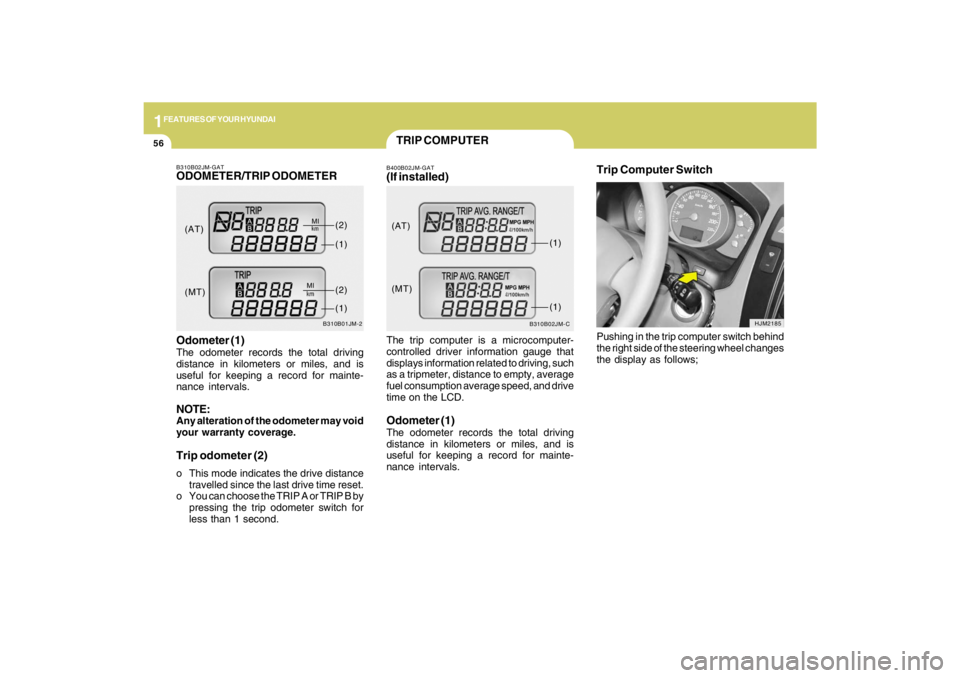
1FEATURES OF YOUR HYUNDAI56
B310B02JM-C
(AT)
(MT)(1)
(1)
TRIP COMPUTERB400B02JM-GAT(If installed)The trip computer is a microcomputer-
controlled driver information gauge that
displays information related to driving, such
as a tripmeter, distance to empty, average
fuel consumption average speed, and drive
time on the LCD.Odometer (1)The odometer records the total driving
distance in kilometers or miles, and is
useful for keeping a record for mainte-
nance intervals.
Trip Computer Switch
HJM2185
Pushing in the trip computer switch behind
the right side of the steering wheel changes
the display as follows;
B310B02JM-GATODOMETER/TRIP ODOMETER
B310B01JM-2
Odometer (1)The odometer records the total driving
distance in kilometers or miles, and is
useful for keeping a record for mainte-
nance intervals.NOTE:Any alteration of the odometer may void
your warranty coverage.Trip odometer (2)o This mode indicates the drive distance
travelled since the last drive time reset.
o You can choose the TRIP A or TRIP B by
pressing the trip odometer switch for
less than 1 second.(AT)
(MT)(1)
(2)(1)(2)
Page 68 of 273
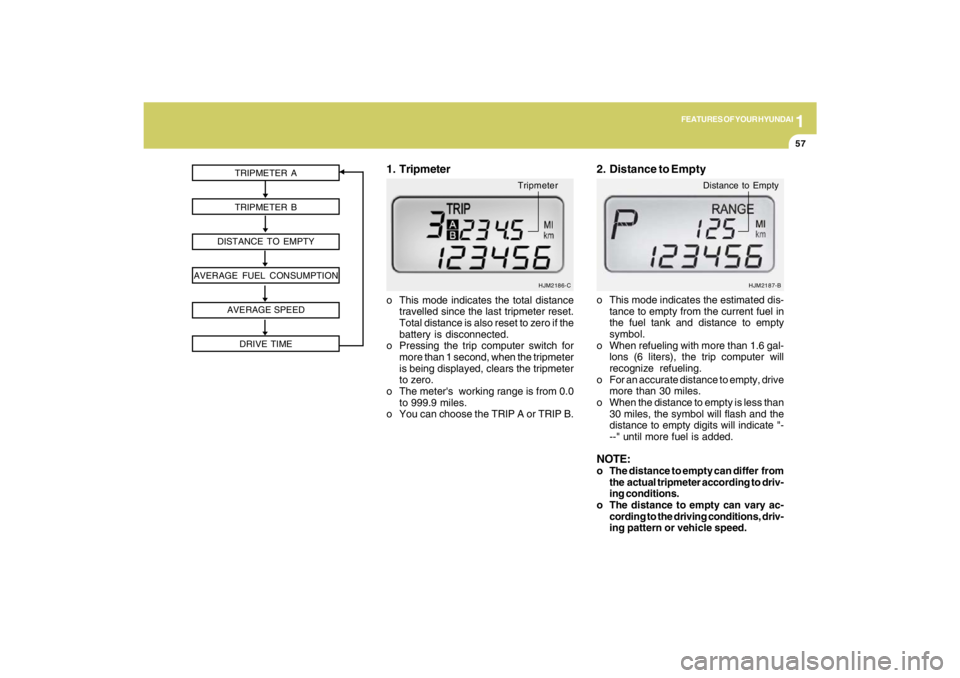
1
FEATURES OF YOUR HYUNDAI
57
TRIPMETER A
TRIPMETER B
DISTANCE TO EMPTY
AVERAGE FUEL CONSUMPTION
AVERAGE SPEED
DRIVE TIME
HJM2186-C
o This mode indicates the total distance
travelled since the last tripmeter reset.
Total distance is also reset to zero if the
battery is disconnected.
o Pressing the trip computer switch for
more than 1 second, when the tripmeter
is being displayed, clears the tripmeter
to zero.
o The meter's working range is from 0.0
to 999.9 miles.
o You can choose the TRIP A or TRIP B.1. Tripmeter
Tripmeter
o This mode indicates the estimated dis-
tance to empty from the current fuel in
the fuel tank and distance to empty
symbol.
o When refueling with more than 1.6 gal-
lons (6 liters), the trip computer will
recognize refueling.
o For an accurate distance to empty, drive
more than 30 miles.
o When the distance to empty is less than
30 miles, the symbol will flash and the
distance to empty digits will indicate "-
--" until more fuel is added.NOTE:o The distance to empty can differ from
the actual tripmeter according to driv-
ing conditions.
o The distance to empty can vary ac-
cording to the driving conditions, driv-
ing pattern or vehicle speed.2. Distance to Empty
HJM2187-B
Distance to Empty
Page 69 of 273
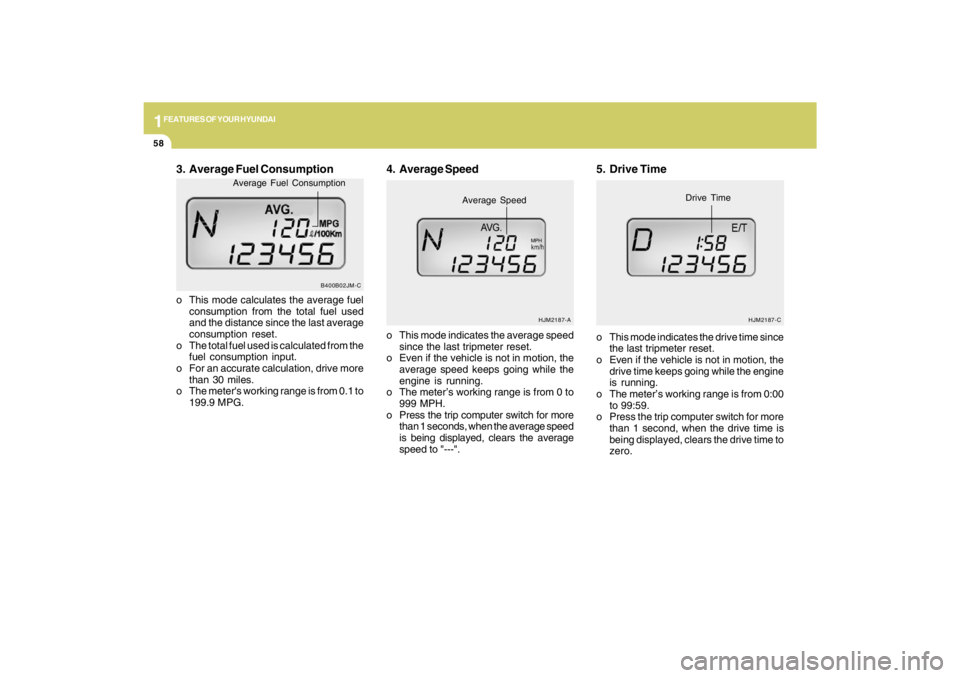
1FEATURES OF YOUR HYUNDAI58
3. Average Fuel Consumptiono This mode calculates the average fuel
consumption from the total fuel used
and the distance since the last average
consumption reset.
o The total fuel used is calculated from the
fuel consumption input.
o For an accurate calculation, drive more
than 30 miles.
o The meter's working range is from 0.1 to
199.9 MPG.o This mode indicates the average speed
since the last tripmeter reset.
o Even if the vehicle is not in motion, the
average speed keeps going while the
engine is running.
o The meter’s working range is from 0 to
999 MPH.
o Press the trip computer switch for more
than 1 seconds, when the average speed
is being displayed, clears the average
speed to "---".
4. Average Speed
HJM2187-A
Average Speed
MPH
5. Drive Timeo This mode indicates the drive time since
the last tripmeter reset.
o Even if the vehicle is not in motion, the
drive time keeps going while the engine
is running.
o The meter’s working range is from 0:00
to 99:59.
o Press the trip computer switch for more
than 1 second, when the drive time is
being displayed, clears the drive time to
zero.
HJM2187-C
Drive Time
B400B02JM-C
Average Fuel Consumption
Page 73 of 273
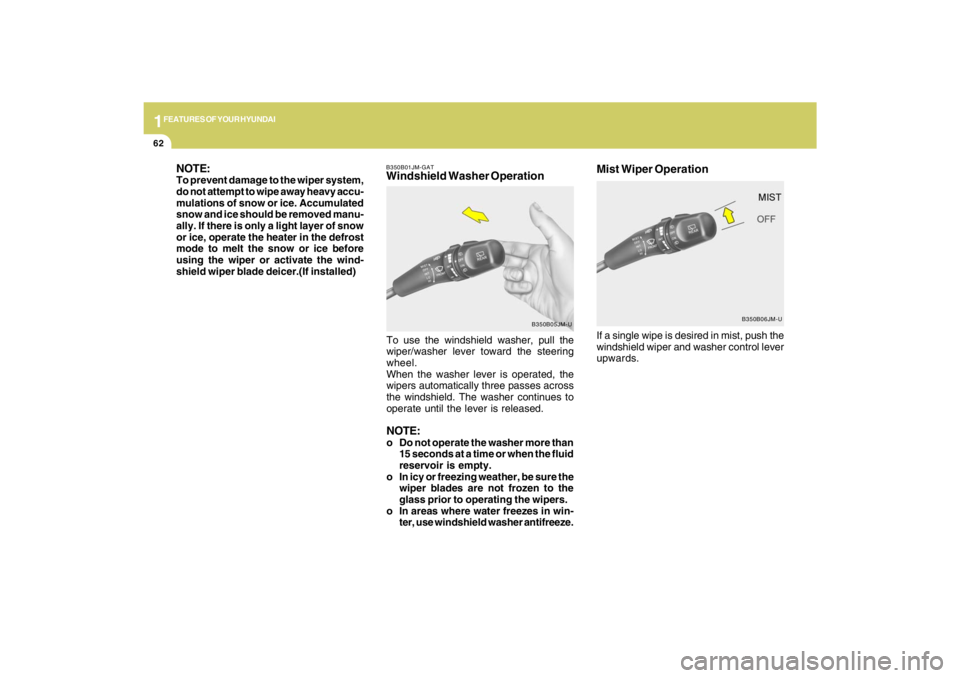
1FEATURES OF YOUR HYUNDAI62
If a single wipe is desired in mist, push the
windshield wiper and washer control lever
upwards.Mist Wiper Operation
B350B06JM-U B350B01JM-GAT
Windshield Washer Operation NOTE:
To prevent damage to the wiper system,
do not attempt to wipe away heavy accu-
mulations of snow or ice. Accumulated
snow and ice should be removed manu-
ally. If there is only a light layer of snow
or ice, operate the heater in the defrost
mode to melt the snow or ice before
using the wiper or activate the wind-
shield wiper blade deicer.(If installed)
To use the windshield washer, pull the
wiper/washer lever toward the steering
wheel.
When the washer lever is operated, the
wipers automatically three passes across
the windshield. The washer continues to
operate until the lever is released.
NOTE:o Do not operate the washer more than
15 seconds at a time or when the fluid
reservoir is empty.
o In icy or freezing weather, be sure the
wiper blades are not frozen to the
glass prior to operating the wipers.
o In areas where water freezes in win-
ter, use windshield washer antifreeze.
B350B05JM-U
Page 106 of 273
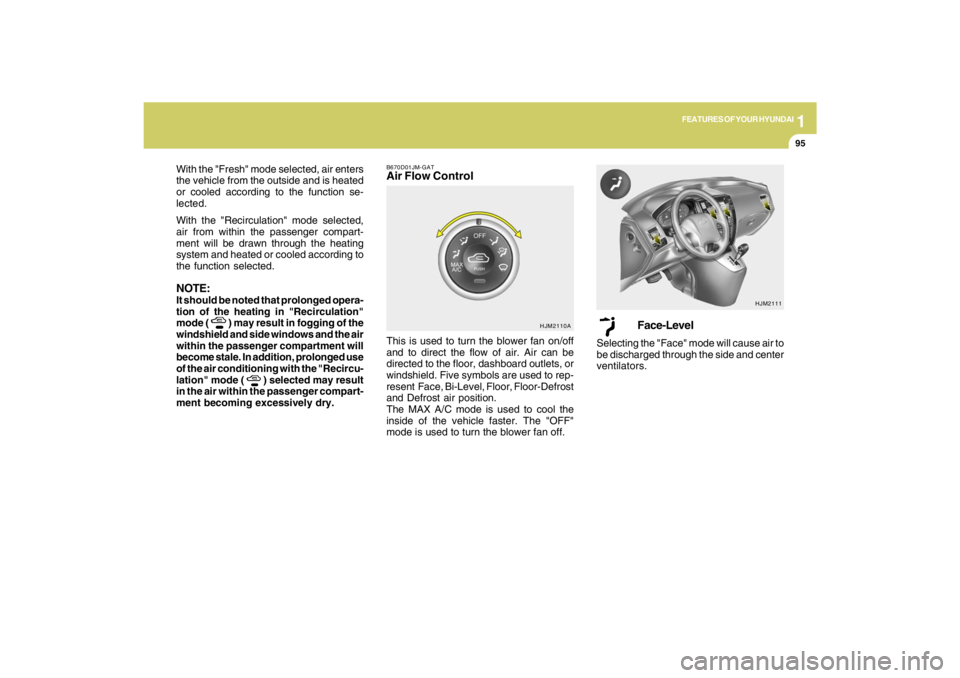
1
FEATURES OF YOUR HYUNDAI
9595959595
With the "Fresh" mode selected, air enters
the vehicle from the outside and is heated
or cooled according to the function se-
lected.
With the "Recirculation" mode selected,
air from within the passenger compart-
ment will be drawn through the heating
system and heated or cooled according to
the function selected.NOTE:It should be noted that prolonged opera-
tion of the heating in "Recirculation"
mode (
) may result in fogging of the
windshield and side windows and the air
within the passenger compartment will
become stale. In addition, prolonged use
of the air conditioning with the "Recircu-
lation" mode (
) selected may result
in the air within the passenger compart-
ment becoming excessively dry.
B670D01JM-GATAir Flow Control
HJM2111
HJM2110A
This is used to turn the blower fan on/off
and to direct the flow of air. Air can be
directed to the floor, dashboard outlets, or
windshield. Five symbols are used to rep-
resent Face, Bi-Level, Floor, Floor-Defrost
and Defrost air position.
The MAX A/C mode is used to cool the
inside of the vehicle faster. The "OFF"
mode is used to turn the blower fan off.
Face-Level
Selecting the "Face" mode will cause air to
be discharged through the side and center
ventilators.